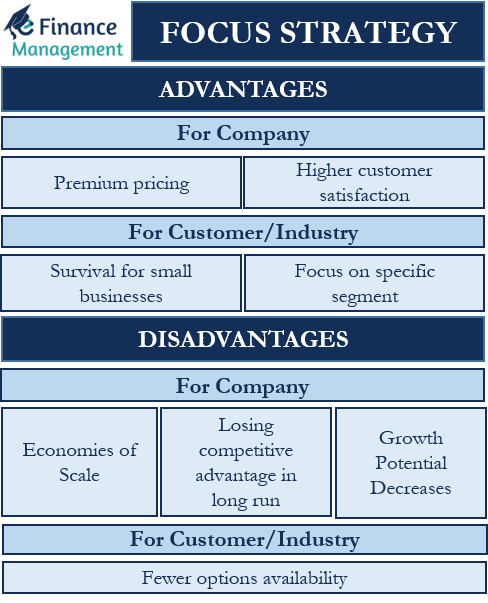Porter’s four generic strategies are the ways that assist a firm in gaining a competitive advantage. Or, in other words, we can say that it gives you an ‘edge’ that increases your sale. The four strategies are Cost Leadership, Differentiation, and Focus (Cost and Differentiation). These strategies are considered to be the continuation of Porter’s five forces. Or, in simple words, we can say that these help a firm get a favorable position in the market. Before a firm adopts any of these strategies, it is important for it to deeply understand its pros and cons. So, in this article, we will talk about the advantages and disadvantages of the Focus strategy.
Before we talk about the advantages and disadvantages of the Focus strategy, let’s understand the Focus strategy.
Focus Strategy – What it is?
A firm practicing this strategy caters to a specific segment (geography or customers). Moreover, a company can either have a cost (cost focus) advantage in that segment or offer a differentiated product (differentiation focus) in the segment.
Papa Murphy’s is a good example of the cost focus strategy. It is one of the biggest Pizza chains in the U.S. To reduce the cost, the company prepares the pizza but doesn’t bake it. Customers need to bake the pizza. This way, it focuses on customers that want to bake their own pizza but want to enjoy a restaurant pizza.
Ferrari is a good example of a brand following a differentiation focus strategy. The carmaker focuses on the high-tech and high-end driving experiences.
Focus Strategy: Advantages
Below are the advantages of the Focus strategy:
For Company
Higher Customer Satisfaction
Under this strategy, a firm caters to the specific wants of clients. This way, it is able to achieve higher customer satisfaction.
Premium Pricing
Since the focus is on a niche market, a company could be able to price its product or service higher. This, in turn, means more profits.
For Customers/Industry
Survival for Small Businesses
This strategy allows small firms to be able to survive in the industry along with big players, and that too profitably.
Focus on Specific Segment
This strategy suits small businesses. It is because, in this strategy, a business has to focus only on a specific segment. Also, it is possible that bigger players don’t feel the urge to cater to that segment, leaving the segment for small businesses.

Focus Strategy: Disadvantages
Below are the disadvantages of the Focus strategy:
For Company
Economies of Scale
Since a firm focuses on a small segment, it may not be able to achieve greater economies of scale.
Losing Competitive Advantage in Long Run
If a firm is able to successfully operate in a specific segment, it could attract more players. This could result in the company losing its competitive advantage. It is possible that the specific market that a firm caters to loses its identity and merges with the bigger market. This way, the firm would lose its competitive advantage.
Growth Potential Decreases
Once the specific market gets saturated, the firm may not have much growth potential.
For Customers/Industry
Fewer Options
Like other Porter’s generic strategies, this strategy also contributes to establishing entry barriers. This not only makes it hard for other players to enter the industry but also means that consumers get fewer options.
RELATED POSTS
- Porter’s Generic Strategies – Meaning, Types, and Example
- Advantages and Disadvantages of Cost Leadership Strategy
- Advantages and Disadvantages of Multidomestic Strategy
- Concentric Diversification – Meaning, Advantages, and More
- Horizontal Diversification – Meaning, Advantages, Examples, and More
- Diversification

